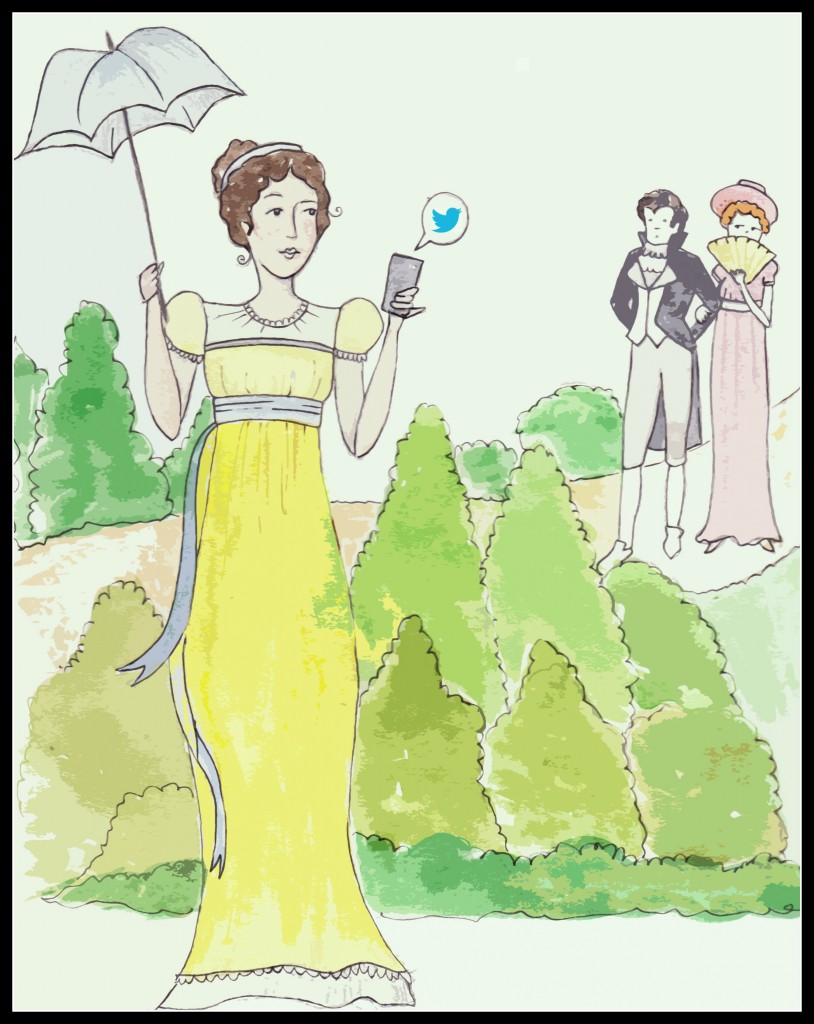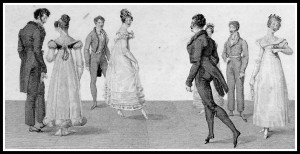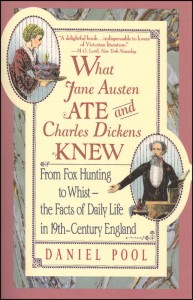by The History Chicks | Aug 8, 2015 | Biography Episode, Episode, Podcasts
She gave us fabulous quotes like, “Men seldom make passes at girls who wear glasses” and “Brevity is the soul of lingerie,” but Dorothy Parker’s life wasn’t all wit and snark. Behind those flip one liners there was a very complex woman who lead a full life far beyond the banter of the Algonquin Round Table.
 How complex was she and how full was her life? It’s going to take two episodes, that’s how much. (It’s okay, we were a little surprised, too.)
How complex was she and how full was her life? It’s going to take two episodes, that’s how much. (It’s okay, we were a little surprised, too.)
It was a dark and stormy night (what? It was!) when Dorothy Rothschild was born in West End, New Jersey at her family’s summer house on August 22, 1893. Her father Henry had fallen in love and married the girl next door, Eliza, and the pair had three children before Dorothy came along. They lived fairly affluently in New York; life as a Rothschild (not those Rothschilds) was very comfortable. (more…)
by The History Chicks | Apr 16, 2013 | Shownotes
A little birdie told us that a lot of you wanted an episode about the life and work of Jane Austen.
That would be several little birdies who tweet, post on facebook, write emails and vote on our Guaranteed Content Poll. During this episode we do exactly what you have asked (over and over again) and chat about the life of author Jane Austen.

The ability to anonymously make wry commentary on social media may have appealed to Miss Austen, but one must wonder if she would have been able to limit herself to a mere 140 characters. (A very special gift from illustrator, Lisa Graves of History Witch)
Jane’s real life wasn’t exactly like the ones that she painted for the heroines in her novels. She was born into a family of modest means and lived that way for her entire life. Like a few of her characters, her best friend and confidante was her sister – but unlike most of them, she never married. Four of Jane’s novels were published but only within her last few years (and she was never credited by name as the author); two more were published after her death. She did enjoy a social life, but lived a very ordinary, quiet and private existence. There is only one confirmed picture of her, and even that was a sketch done by her sister. People who knew Jane claimed that it didn’t quite capture her appearance. Oh, Jane, this is but one mystery in your wake!

Sketch on left done by sister Cassandra (she looks irritated, right?) Portrait on right based on that sketch was created many years later
Jane Austen was born December 16, 1775 at Steventon Rectory, Hampshire England where her father, George, was the Oxford-educated parish Rector. Jane was the seventh of eight children, and only the second daughter. Sister Cassandra (who was three years older and named after Mum) would remain close to Jane for her whole life. Parents Austen believed strongly in education and reading and maintained a very loving (and wildly rambunctious) household. Not only was the home filled with Austen children, but Rev. Austen took in several more boys and turned the home into a boarding school.
After a relatively brief and traumatic stint at a couple of girls boarding schools, Jane’s formal education was complete. Her father’s library and educational materials were available to her and, supplemented by the occasional tutor, she learned to play the piano, speak French, some Italian and do needlework. And she wrote. Quite a bit. Not merely letters, which were the primary communication device of the time, but she began to write poems, short stories, plays and short novels. This collection of work is now known as Jane’s Juvenilia which was eventually published in the 1930’s. The most humorous to us is this 15 page History of England from the Reign of Henry the 4th to the Death of Charles the 7th: By a Partial, Prejudiced and Ignorant Historian. Illustrated by sister Cassandra, it shows the early wit of a writer who would later mock many a social convention.
As the Austen sisters grew to a marrying age both had episodes of love and heartbreak. Cassandra was engaged for a period, although he died while attempting to earn enough money for them to marry. Jane had two recorded (and one suggested and mysterious) relationships. The first was a hot and heavy flirtation with a young man who, when his parents realized he was smitten with the unmonied Jane, was made an offer he couldn’t refuse and left Jane. The second was a very (oh so very) brief engagement that lasted a whole evening. It wasn’t that Jane didn’t like to socialize, she was very social and loved to dance- but this is one more mystery in her legacy.

Quadrille, a popular dance of Jane’s time.
Why so much mystery? Certainly there was correspondence, or some type of primary source documentation? There was. Accent on “was”. For some reason, Cassandra (as well as some of the Austen brothers) destroyed most (as in: several thousand down to a couple hundred) of the letters that Jane sent. Most of the story of her adult years had to be cobbled together through other accounts, and some parts will never, truly be understood. For instance: As two unmarried women of the time Jane and Cassandra were utterly dependent upon their family for survival. When Papa retired, the foursome moved to Bath. Jane’s opinions about the move as well as how she felt during that time are mostly unknown as she stopped writing her as yet unpublished novels, and there are few letters that remain from her.
We do know that she carried around three manuscripts- precious cargo they were- as she traveled to visit family and friends while Bath was her home base. Later, she lugged them around again as she and her female relations set to find financial support after the death of her father. It wasn’t until Jane, Cassandra and their mother set up house in Chawton Cottage, part of a property owned by an elder brother, did Jane begin to write again.

Chawton Cottage- Jane’s last happy home and now a museum
And write she did!
In 1811 Jane’s first novel, Sense and Sensibility was published in three volumes. We will cover all of Jane’s books in a separate episode, but publication came pretty quickly from this point until her death. Pride and Prejudice, Mansfield Park and Emma followed in print over the next few years.

First edition Sense and Sensibility by Jane…er, no, sorry…by A Lady.
However, Jane became ill- weak and in chronic pain- her writing slowed down. On July 18th, 1817 at the age of 41, Jane Austen died in the arms of her beloved sister. Her final two novels, Persuasion and Northanger Abbey were published together after her death. We cover many more details of Jane’s life, as well as some interesting tidbits about the Georgian and Regency periods, in the podcast. We also discuss Jane’s long lasting appeal- why her chronicling and wry observations of the Regency period ignite a level of intrigue in millions wonder who still wonder what other works she may have had in her future if death hadn’t stilled her passion.
TIME TRAVEL WITH THE HISTORY CHICKS
Make your plans now to attend one of any number of events worldwide commemorating the 200th anniversary of Pride and Prejudice! Here is a calendar! The closest to us is in Louisville…hmmmm?
You want to meet the other Janeites, right? Get in-depth information and talk about every aspect of the life and work of this woman? Visit the website (facebook page, twitter) of your nearest Jane Austen Society and dive in. Jane Austen Society of North America.
Google it yourself, there are so many websites devoted to Jane that we couldn’t possibly compile a list, merely give you a few to start with. How about- The Republic of Pemberley? This site is a feast of intel and hosts an active community.
Or maybe- Seeking Jane Austen.com which is a guide to the locations associated with Jane.
Jane Austen Fight Club video!
For the over 21 crowd: The Jane Austen Drinking Game. (Countenance: A calm and composed facial expression. Continence: The ability to retain bodily discharge. Yes, let’s all laugh again.)
While you are clicking around online, go take a tour of Jane Austen’s House Museum which is kind enough to provide a virtual tour (Oh, you know we love a good virtual tour). This is is where she wrote the bulk of her published novels and was her last home. Or better: plan a trip around Austen! There are maaaany websites to assist you on this, and most of the links we provided will get you started, here is one to start with The World of Jane Austen. Remember to send us a postcard!
Books! Again, we had a stack of materials to choose from and narrowed it down to our favorites (although many others were quite good and it is fair to say that we have OD’d on Austen)

By Adams, Buchanan and Gesch

By Daniel Pool

Catherine Reef (YA book)

Claire Tomalin

Natalie Tyler

Jane Austen: A family Record (this is the book Beckett sniffs) by William Austen-Leigh and Richard Arthur Austen-Leigh
We always recommend Supersizers, Go! and they don’t disappoint with the episode based on the Regency Period.
A very big thank you to Lisa Graves who crafted the irrelevant Jane illustration tweeting from the top of this post. We both adore her work and style (she also graciously did the illustration for our Julia Child episode) and are thrilled to share that she has author/illustrated a History Witch book coming in June! Visit her site History Witch for more of her charming women’s history illustrations and oddities about some of histories most colorful women.
As always, our music comes courtesy of Music Alley. Visit them at Music.mevio.com
(Closing song: Know Which Way the Wind Blows” by The Postmarks)
by The History Chicks | Oct 23, 2011 | Biography Episode, Episode, Podcasts
Imagine that you had ideas that were so radical for your time that it would take a couple of hundred years for them to be accepted? Can you imagine that your lifestyle would be given more attention in those years than your message? Can you imagine that your most important work was often mispronounced?
Such was the life of the woman we spoke of this week, Mary Wollstonecraft.

Born April 27th, 1759 in London, as the second of seven children to Edward and Elizabeth. Her birth station in life was one of upper middle class. However her father pretty much squandered his inheritance, and the family moved frequently. Each time they did it was a step down to a less affluent home. Dad was a drinker, and pretty abusive…it really wasn’t a warm and happy childhood.
Mary had a couple of close friends as well as some neighbors who cared for her, helped her with her education as well as providing bright spots in a pretty bleak life. Her future prospects didn’t seem very promising.
For an unmarried woman of her time and social class she took up pretty much every career that was available to her.
Lady’s Companion?
Fail.
School Teacher?
Good…for a bit.
Governess?
Not so great.
Of course we go into more detail in the podcast, but she left home at 19 to try and make a living. She supported her sister Eliza, who she helped leave a possibly abusive marriage. She tried to also hang out as long as possible with her friend, Fanny Blood- but conventional lifestyles were not really her thing and they were very much Fanny’s thing.
“I am not born to tread in the beaten track – the peculiar bent of my nature pushes me on.” Mary Wollstonecraft wrote to her other sister, the cooler named Everina.
She got that right.
Finally she ends up in London, working for a man named Joseph Johnson, a book publisher. He encourages her in her writing, and write she did. Children’s books, reviews , and her first novel – entitled Mary- a fiction, which was based on her travels to Portugal to attend the birth- and unexpected death- of Fanny Blood and her first child.
She wrote a book about what she learned as the head of a school, and as a Governess, with the lengthy title, “Education of Daughters: With Reflections on Female Conduct in the More Important Duties of Life.”
Got that?
She also established herself as a political writer with the publication of The Vindication of the Rights of Men, which was a rebuttal of piece written by Edmund Burke.
And on the heels of that document she wrote the biggie: A Vindication of the Rights of Woman: With Strictures on Political and Moral Subjects. Did you catch that? ” WOMAN” Not “womEn” as is often mistaken. Even in this podcast. *coughbySusancough*
What is it about? Well, ENTIRE college level courses are devoted to this work, so we can’t sum it up here. But try this version:
-Women are only inferior due to their inferior education
-All minds are equally receptive to knowledge no matter what package they arrive in
-Women ought not to have power over men, but over THEMSELVES.
(Plus 449 more pages of important information)
While she was starting to grow in both works and audiences as a writer, her personal life was a mess.
She fell in love with artist Henry Fuseli and went so far as to ask his wife if they can all live under one roof. Yeah. That went over well. (No, it really didn’t).

Then she falls in love with American Gilbert Imlay. This relationship produces a daughter, Fanny, as well as a lot of scandal. Imlay claims her as his wife while they are in France ( just watching the French Revolution), although they are not legally married. Mary settles into life as a mother, but Imlay didn’t sign up for such domesticity and is gone for longer and longer times. yadda yadda…two suicide attempts and a business trip to Scandinavia later- he moves in with another woman.
Mary, Mary, Mary…sigh…

Enter William Godwin. The two had traveled in similar social circles in London before life mellowed out Mary. He fell in love with her through her writing and finally they see eye to eye ( as well as other body parts) and begin a fast romantic relationship. He gets her, she gets him, they get pregnant and married.

The end.
Ok, not quite…she gives birth just a mere year after their romance for the ages begins. Ten days after the arrival of baby Mary Godwin, Mary Wollstonecraft dies from complications after childbirth. This left the love of her life to raise her two daughters, Fanny and Mary–who will grow to become Mary Shelley, author of Frankenstein.
And just because you don’t think that this story can’t get any more tragic: In an act of deep mourning and love Godwin publishes her letters in an attempt to show the world what a remarkable and special woman she was. Memoirs of the Author of A Vindication of the Rights of Woman. With this book, all the details of her private life are revealed and her reputation is trashed for a couple hundred years.
Ouch.
Time Travel With The History Chicks
You can read A Vindication of the Rights of Woman. Or you can listen to it – Librivox has it for free on itunes.
We know, you want to read the one that trashed her reputation…naughty listener! 18 bucks on Amazon or download it to your Kindle free!

The letters of Mary Wollstonecraft are available in many different books, as are a good number of her works.
The Collected Letters of Mary Wollstonecraft compiles a great number of her letters.

And you REALLY want to watch this, we know you do.
http://www.youtube.com/watch?v=qjalBmkmkvE
And now that you are really into the life of this woman, check out this blog, or follow Mary on Twitter ( we kid you not!) http://avindicationoftherightsofmary.blogspot.com/p/mary.html
****CORRECTION! Sharp listener Jacki caught a slight faux pas in our Drop Into History segment! George Washington’s wife’s maiden name was Custis, not Curtis. Sorry for the error!*********
As always, music comes courtesy of Music Alley, music.mevio.com
 How complex was she and how full was her life? It’s going to take two episodes, that’s how much. (It’s okay, we were a little surprised, too.)
How complex was she and how full was her life? It’s going to take two episodes, that’s how much. (It’s okay, we were a little surprised, too.)


















